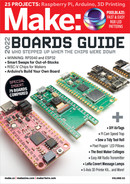
In the early 1950s, aircraft development created
an urgent need for simulations, and analog
computers were ideally suited to run flight
simulators.
Digital computers barely existed in those days,
but aircraft dynamics could be modeled by the
flow of electric current through potentiometers,
amplifiers, and capacitors. Such circuits were
analogous to the real world, and so they became
known as analog computers.
You could describe almost all aspects of
aircraft performance with differential equations,
and the terms in these equations were
represented by chaining together analog modules
using patch cords on a plug board. This created
a formidable tangle of wires, but once you got it
right, the output on an oscilloscope screen was
immediate, with no processing or programming
necessary. Figure
A
shows an installation at the
NASA Glenn Research Center in 1956. (Note the
plug boards.)
As late as 1963, analog computation was still
being used to create a cockpit simulation of a
space vehicle docking in orbit. But microchips
promised greater accuracy with much less
maintenance, and they became less expensive.
By the mid-1970s, analog was obsolete.
Or was it?
In 2020, Professor Doctor Bernd Ulmann
cofounded Anabrid GmbH in Frankfurt, Germany,
to develop chip-based analog computers. The
company also introduced an educational product
named The Analog Thing (the-analog-thing.org),
abbreviated as THAT. Digital computers running
complex simulations had become increasingly
power-hungry and plagued with problems such
as heat dissipation, prompting Ulmann and his
colleagues to foresee a new role for analog.
THAT is now available to buyers in the United
States for less than $350, including shipping
(see Figure
B
). “Our goal is to bring the idea of
analog computing back to the world,” Ulmann
states. “We have hobbyists, musicians (controlling
analog synthesizers), many students, sometimes
large companies. There is a THAT group at
Facebook where users ask questions and post
their computer setups. They have simulated
events such as a bungee jump with a quite
realistic rubber rope, and gravitational waves,
neurons, many more.”
Ulmann claims that seriously challenging
tasks, such as creating an epidemiological model,
“can be done easily” with THAT. And if a problem
gets too big, one THAT can be daisy-chained with
another. The key is to express a phenomenon as a
series of mathematical terms, each represented
by a computing element. Connect them together,
and the input flows directly to the output.
THAT is open-source, because Ulmann wants
to encourage innovation and analog literacy,
although he sees THAT being integrated with
digital systems. “We have a little application
example showing how an Arduino can be used as
the digital part of a hybrid computer setup,” he
says. “The community has already come up with a
data logger and an Arduino-based oscilloscope.”
And to spread the gospel, he has written a book
titled Analog and Hybrid Computer Programming.
Meanwhile, you can build your own basic
analog computing device for around $5 (see the
following project) to understand how they work.
Oscar Roselló
105
make.co
Two EAI PACE analog computers back in the day, 1956.
Anabrid GmbH , NASA
A
B
The Analog Thing, also known as THAT, 2022.
M83_104-7_EFF_F1.indd 105M83_104-7_EFF_F1.indd 105 10/11/22 10:44 AM10/11/22 10:44 AM
..................Content has been hidden....................
You can't read the all page of ebook, please click here login for view all page.
